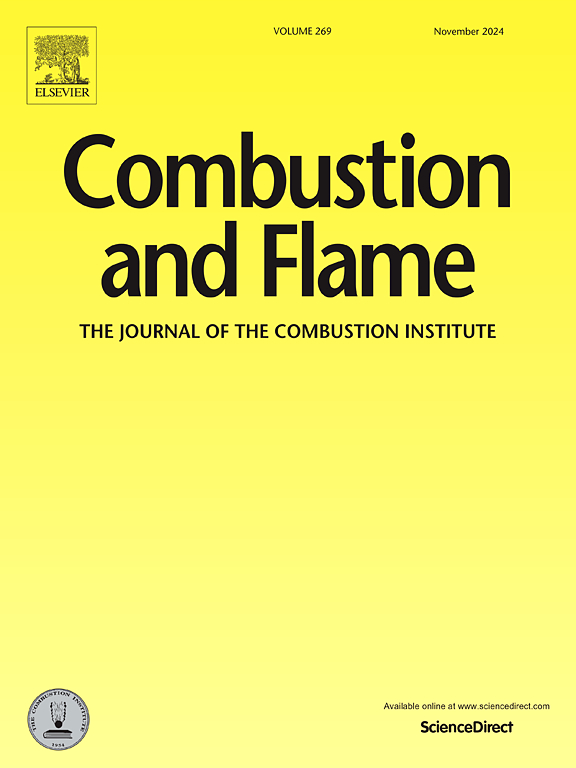Effects of obstacle hole shape, obstacle position and ammonia ratio on hydrogen-ammonia-air flame dynamics in a horizontal closed duct
IF 5.8
2区 工程技术
Q2 ENERGY & FUELS
引用次数: 0
Abstract
As a carbon-free energy carrier, hydrogen-ammonia mixture has significant development potential in internal combustion engine applications. To clarify the coupling mechanisms between flame acceleration and explosion overpressure generation, the effects of obstacle hole shape, obstacle position, and ammonia ratio on flame evolution, flame tip speed, and pressure dynamics on hydrogen-ammonia-air flame in a horizontal closed duct were investigated. Specifically, the obstacle positions in this study were determined based on the three different stages of flame evolution: 1) the finger-shaped flame acceleration stage, 2) the flame skirt-wall contact deceleration stage, and 3) the tulip flame speed fluctuation stage. The objective is to investigate the influence mechanisms of obstacles at each stage. For flame evolution and flame tip speed, the obstacle installed at the tulip flame stage (#3) induces the strongest flame turbulence intensity, followed by the obstacle located at the flame skirt wall-contact stage (#2), with the lowest turbulence intensity observed for the obstacle installed in the early finger-shaped flame stage (#1). The enhancement effect of obstacle #2 on flame acceleration is the most significant, as the flame tip speed reaches its peak at the flame skirt wall-contact stage (#2). For pressure dynamics, the pressure fluctuation amplitude is greatest under obstacle #2 condition, while it is smallest under obstacle #3 condition due to the irregular flame front disrupting the reflection of pressure waves. For the explosion overpressure generation mechanism, the theoretical model exhibits good predictive performance, with the theoretical results effectively reproducing the experimental explosion overpressure. The acceleration factor can quantify the flame acceleration effects well and also reveal that the flame acceleration effect on flame tip speed is a key factor influencing explosion overpressure and pressure rise rate.
障碍孔形状、障碍位置和氨比对水平密闭管道中氢-氨-空气火焰动力学的影响
作为一种无碳能源载体,氢氨混合物在内燃机应用领域具有巨大的发展潜力。为了阐明火焰加速和爆炸超压产生之间的耦合机制,研究了水平封闭管道中障碍物孔形状、障碍物位置和氨比例对氢氨空气火焰演化、焰尖速度和压力动态的影响。具体来说,本研究中的障碍物位置是根据火焰演化的三个不同阶段确定的:1) 指状火焰加速阶段;2) 火焰裙壁接触减速阶段;3) 郁金香火焰速度波动阶段。目的是研究各阶段障碍物的影响机制。在火焰演变和焰尖速度方面,设置在郁金香火焰阶段的障碍物(3 号)引起的火焰湍流强度最大,其次是位于火焰裙壁接触阶段的障碍物(2 号),而设置在早期指形火焰阶段的障碍物(1 号)引起的湍流强度最小。2 号障碍物对火焰加速度的增强作用最为显著,因为焰尖速度在火焰裙壁接触阶段(2 号)达到峰值。在压力动力学方面,2 号障碍物条件下的压力波动幅度最大,而 3 号障碍物条件下的压力波动幅度最小,这是因为不规则的火焰前沿破坏了压力波的反射。对于爆炸超压的产生机理,理论模型表现出良好的预测性能,理论结果有效地再现了实验爆炸超压。加速因子可以很好地量化火焰加速效应,同时揭示了火焰加速效应对火焰尖端速度的影响是影响爆炸超压和压力上升率的关键因素。
本文章由计算机程序翻译,如有差异,请以英文原文为准。
求助全文
约1分钟内获得全文
求助全文
来源期刊

Combustion and Flame
工程技术-工程:化工
CiteScore
9.50
自引率
20.50%
发文量
631
审稿时长
3.8 months
期刊介绍:
The mission of the journal is to publish high quality work from experimental, theoretical, and computational investigations on the fundamentals of combustion phenomena and closely allied matters. While submissions in all pertinent areas are welcomed, past and recent focus of the journal has been on:
Development and validation of reaction kinetics, reduction of reaction mechanisms and modeling of combustion systems, including:
Conventional, alternative and surrogate fuels;
Pollutants;
Particulate and aerosol formation and abatement;
Heterogeneous processes.
Experimental, theoretical, and computational studies of laminar and turbulent combustion phenomena, including:
Premixed and non-premixed flames;
Ignition and extinction phenomena;
Flame propagation;
Flame structure;
Instabilities and swirl;
Flame spread;
Multi-phase reactants.
Advances in diagnostic and computational methods in combustion, including:
Measurement and simulation of scalar and vector properties;
Novel techniques;
State-of-the art applications.
Fundamental investigations of combustion technologies and systems, including:
Internal combustion engines;
Gas turbines;
Small- and large-scale stationary combustion and power generation;
Catalytic combustion;
Combustion synthesis;
Combustion under extreme conditions;
New concepts.
 求助内容:
求助内容: 应助结果提醒方式:
应助结果提醒方式:


